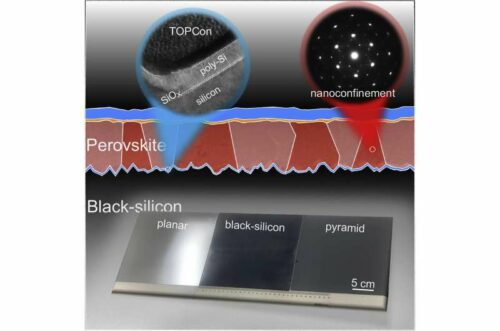Researchers from China have developed high-efficiency monolithic perovskite/black silicon TOPCon tandem solar cells that improve the stability of the device and increase power conversion efficiency (PCE)

It is difficult to improve the performance of solar cells as they need huge investments and had limited light-trapping capabilities. Perovskite/silicon tandems offer an increase in the PCE of solar cells at a relatively low cost. Hence, a research group led by Prof. Ye Jichun at the Ningbo Institute of Materials Technology and Engineering (NIMTE) of the Chinese Academy of Sciences (CAS) has developed high-performance monolithic perovskite/black silicon (b-Si) solar cells with tunnel oxide passivated contact (TOPCon) that enabled them to achieve a certified power conversion efficiency (PCE) of 28.2%.
This first monolithic perovskite/Si tandem solar cell is based on industry-relevant b-Si with TOPCon structures. Combined with the TOPCon, the surface reconstruction of the b-Si contributes to an excellent trade-off between high-level surface passivation and broadband light trapping. The reconstructed nanotexture of b-Si can significantly increase the moisture resistance and promote the wetting of perovskite. The b-Si also guides the vertically aligned crystal growth of perovskite through the nanoconfinement effect, reducing carrier recombination and facilitating carrier collection. Further, b-Si reduces the film strains, thus improving the stability of the device.
With an open-circuit voltage of 1.80 V, fill factor of 81.8%, and a short-circuit current density of 19.2 mA/cm2, the prepared monolithic perovskite/b-Si TOPCon tandem solar cells yield a remarkably high certified PCE of 28.2%, which is among the highest reported values for perovskite/Si solar cells with either TOPCon or double-side-textured Si to date.
The research will assist in the development and fabrication of high-performance perovskite/b-Si tandem solar cells.
Click here for the Published Research Paper








